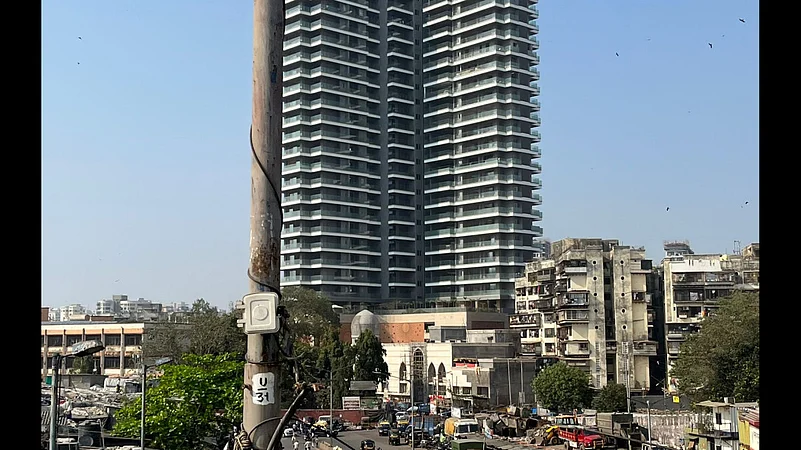When Asha Manohar Diwar came to Kamathipura as a young bride she was fascinated by all the gaudiness she saw around her. Hailing from the temple town of Shirdi, her life had been too staid. The thought of settling down in Mumbai had excited her and she was eager to show her parents her new home, a one room kitchen flat in the Alishan building in Kamathipura’s 10th lane.
She soon realized that the gaudiness was part of the trappings that made a redlight district. Excitement gave way to panic and she wanted to go back to her parental home, but her marital family held her back saying there would be redevelopment soon. She has never been able to invite anyone home due to the stigma of the area.
Sanjay Leela Bansali’s recently released Hindi flick Gangubai Kathiawadi, based on the life of one of the most powerful brothel owners of Kamathipura has put the spotlight on this area. The gaudiness of Kamathipura is timeless and this vibrant area has worn many hats – one such epoch was that of the redlight district. The Alia Bhatt starrer, based on a chapter from crime writer Hussain Zaidi’s book Mafia Queens of Mumbai, is being bandied as the true picture of Gangubai, who wielded considerable clout not only in Kamathipura but also with the then underworld don Karim Lala.
For those like Asha who have not seen the grandeur of the Gangubai era, cannot understand the fuss of the film. “She had a brothel where women were made to work. Now, this area has a bad name because of the brothels,” said Asha.
Since that day about 30 years ago, that new bride Asha, now 60 years old has waited for Kamathipura’s new face, a visual shift that would give the area more acceptability to the world outside its length and breadth. Over the years the word “redevelopment” stopped weaving its magic on her as every time someone had uttered it, Asha would be transported into fantasyland – her 180 sq ft home would magically turn into a two BHK flat with sofas, chairs, a bed and the privacy of closed doors.
“My instincts tell me that this time there will be redevelopment,” said Asha to Outlook. “I waited for it in my youth, hope in my old age we can have comfortable living quarters,” she said.
Hers is not an isolated story. This is the sentiment that runs high in every one of Kamathipura’s households. “The redevelopment is not a fantasy it will be a reality. Everyone in Kamathipura will live a better life. The Maharashtra Government is very serious about it and the residents will soon start seeing the results,” said Amin Patel, Congress Party MLA from Mumbadevi. Kamathipura comes under the purview of the Mumbadevi constituency. “Housing minister Jitendra Awhad has visited this place and held meetings here. He has also galvanized the government machinery and the plan is moving forward,” said Patel to Outlook.
Though this is Patel’s third term as MLA, it is only now that the blueprint for the redevelopment has picked up speed. “We have been working on this plan for a long time. It has taken several years to reach this stage where it is now speeding ahead. The state cabinet will discuss it soon and the implementation too will begin soon,” he said. Though Patel sounds positive on starting the project soon, Kamathipura is a complicated case, like the other parts of Mumbai where redevelopment projects are underway.
Sub-tenancy and the Pagdi system drive the impediments in the smooth implementation of this project. The Pagdi system is a form of tenancy in India, where the tenant is also part owner of the property but not the land. As per the Maharashtra Rent Control Act of 1999, the Pagdi system was made legal.
Prior to 1999, there was no need for the tenant to get into a contract with the landlord for a lease. Rent receipts took care of the whole process. Year after year the rents would remain the same, not being affected by the inflation. The land owner could confer a kind of ownership to the tenant for a deposit of money. This partial ownership means that the tenant has a certain edge over the property but not the land. The part owner can even sublet the premises, but the rent that is received must be divided between the actual owner of the property and the part owner i.e. the first tenant.
Since individual holdings by landlords are small in Kamathipura, it has become difficult to get builders interested in taking up projects here. “It is a consortium that will take up the project in Kamathipura. The people want cluster development with amenities. This redevelopment will completely change the face of the area,” said Patel.
Over 39 acres of prime real estate constitutes Kamathipura. Centrally located it is connected to every major point in south Mumbai, including train, metro and bus stations. Though, architecturally this may not be the most interesting part of Mumbai with its lingering seedy and sleazy elements, Patel’s aim is to make the area more family friendly and commercially mainstream.
“It will be a vibrant and throbbing centre and the busiest point in Mumbai once the redevelopment is done. Seeing is believing,” said Patel. He rounded off saying that this project is not just a political assurance but an emotional one too. For those like Asha, who have been stringing their dreams for decades on end, the reality of redevelopment may touch them soon.
















